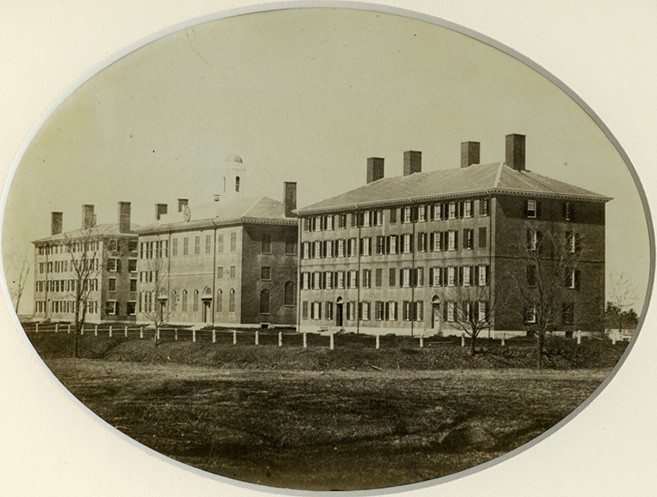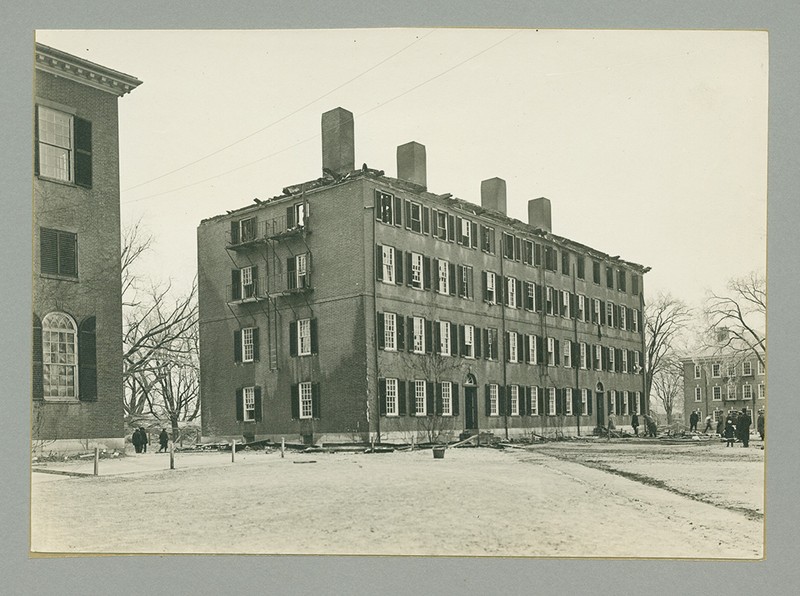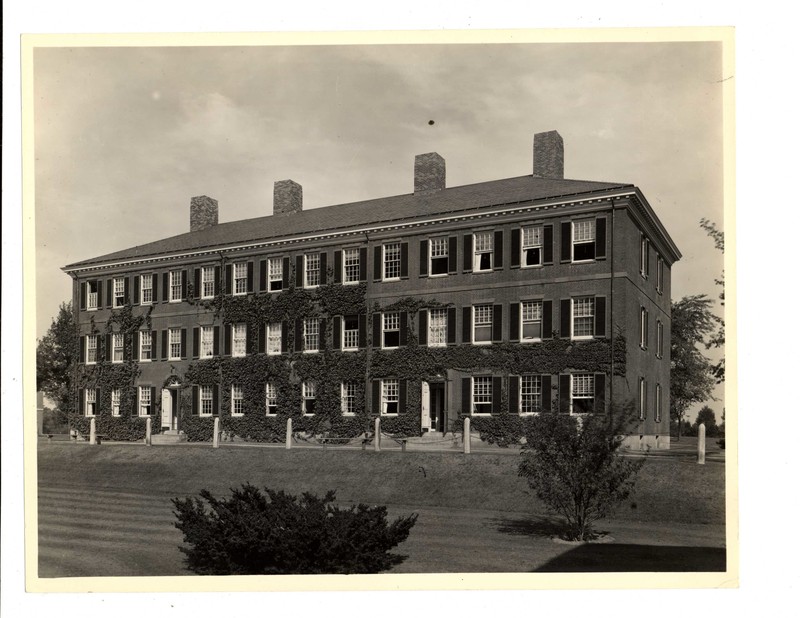Bartlet Hall, 1820-1821, at Phillips Academy
Introduction
Text-to-speech Audio
Paid for by strict Calvinist William Bartlet (1747-1841), a Newburyport shipowner, merchant, and textile manufacturer, Bartlet Hall was built in 1821 as a second dormitory and mate to Foxcroft. Modest Federal details, including recessed entries with lunettes and paneling, a cornice with modillions, four large square chimneys, windows with multi-pane lights, and splayed brownstone lintels, survive extensive remodeling. In 1914 the building was completely gutted by fire and rebuilt. In 1929, Bartlet, like Foxcroft, was lowered to harmonize with surrounding architecture. Bartlet and Foxcroft remain dormitories.
Images
Seminary Row, Bartlet Hall at left, 1860s

Bartlet Hall fire on December 8, 1914

Bartlet Hall

Backstory and Context
Text-to-speech Audio
Starting in 1808, William Bartlet donated $160,000 to Andover Theological Seminary over the course of four decades. Nearly half of that money he spent erecting five buildings: Phelps House (1809-1910), Moses Stuart Houses (1810-1811), Pearson Hall (1817-1818), Bartlet Hall (1820-1821), and Park House (1833-1834). In each case (except Park House), Bartlet served as his own contractor, hiring builders, purchasing materials, and paying the bills.
Born to a modest family in 1747, Bartlet worked for years as a shoemaker, his father’s trade, before earning enough to invest his savings in a merchant ship. Bartlet’s initial forays into commerce were successful enough to establish himself in trade and leave shoemaking behind. Bartlet made his fortune dealing in molasses, sugar, rum, cotton, iron, copper, salt, coffee, indigo, fish, limes, wine, linens, and a variety of other goods. The vessels he funded traversed well-known routes between Newburyport, the Caribbean, and European ports.
Conspicuous in its absence from his ship ledgers is any reference to enslaved peoples. Bartlet, the evidence suggests, had no desire to invest in the slave trade. And he had the opportunity; Bartlet’s ships made port at colonies whose productivity and wealth were based on slave labor: Martinique, Guadeloupe, Surinam, Trinidad, St. Kitts, and (until 1794, when a slave revolution brought about emancipation) Saint Domingue. In 1791, one of Bartlet’s ships called the Polly sailed for the coast of Guinea in Africa. Even there, on what European ship captains called “the slave coast,” Bartlet instructed his own captain, Edward Preble, to sell their cargo of rum and avoid speculating in the slave markets. (Preble later described the voyage to Guinea as a financial disaster, bringing home just 5£ net profit for the creditors.)
What kept Bartlet from engaging in the slave trade? Religious conviction was one possibility; he was a devout man (which explains his philanthropic contribution to the ATS), although plenty of Christian men involved themselves in slavery. Business prudence may have influenced him; there was more risk in buying and selling human captives than trading in conventional commodities. Nor is it likely that the brigs Bartlet funded in Newburyport were specifically built to hold human cargo. Whether or not Bartlet believed he was keeping his hands clean from the stain of the slave trade, he still profited mightily from the stolen labor of enslaved peoples. The salted cod that his ships brought south to sell in the Caribbean served as a chief source of nutrition for the enslaved labor force. Molasses, sugar, coffee, and indigo cultivated by enslaved people working tropical plantations brought premium prices in New England and Europe. Those sugar and coffee colonies frequented by Bartlet’s ships were the most valuable land on earth, wealth indisputably derived from slavery.
How should the name and history of William Bartlet be represented on campus?
How should we understand and react to the legacy of slave labor that, even if indirectly, funded the ATS and made possible some of the oldest and most important buildings on the Phillips Academy campus?
Sources
Academy Hill: The Andover Campus, 1778 to the Present. New York: Princeton Architectural Press, 2000.
Allis, Frederick S., Jr. Youth From Every Quarter: A Bicentennial History of Phillips Academy, Andover. Hanover, NH: University Press of New England, 1979.
Domingue, Robert A. Phillips Academy Andover, Massachusetts: An Illustrated History of the Property (including Abbot Academy). Wilmington, Mass.: Hampshire Press, 1990.
Montgomery, Susan J. and Roger G. Reed. Phillips Academy Andover: An Architectural Tour. New York: Princeton University Press, 2000.
Phillips SAcademy Archives and Special Collections
